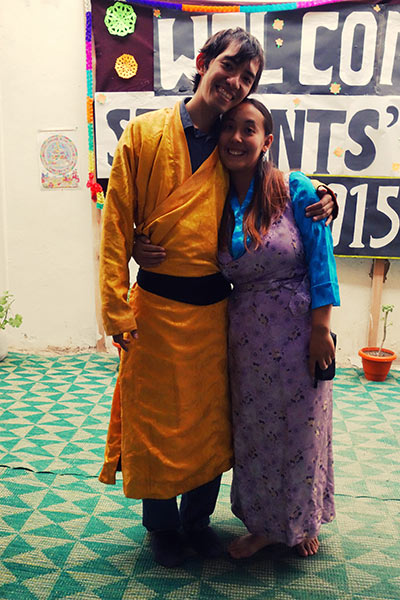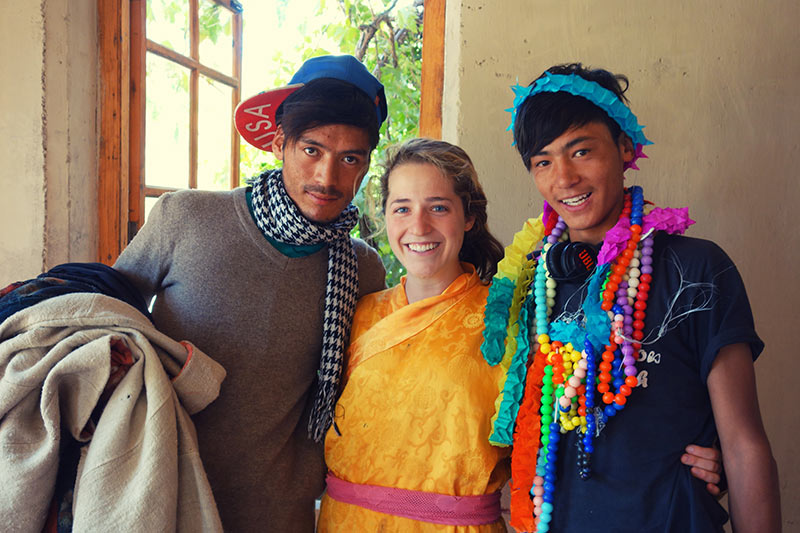Somewhere Worthwhile - SECMOL
Our original plan was to stay at SECMOL for one month, but after more than a month and a half, we are only now barely able to tear ourselves away. It's an amazing place, and I had some of the best experiences not only of this trip but of my life there.
What is SECMOL? It's an alternative school in Ladakh, a region in northern India. The school's name stands for the Students Educational and Cultural Movement Of Ladakh, a name that reflects the mission of its founder, Sonam Wangchuk. Sonam Wangchuk is a visionary who founded SECMOL in 1988 to reform the educational system of Ladakh, develop ecofriendly solutions to environmental projects, and give students a sense of their cultural heritage as Ladakhis.
First the people. The students are from all over Ladakh, and when we first arrived at the beginning of September, they had already been getting on with each other fabulously for the past two months. SECMOL is like a boarding school in that all the students live, study, and work there. These are students who have "failed" their 10th grade final exams, but "failed" is a relative term because currently around 60% of all Ladakhi students fail one or more of their 10th grade exams. It's more accurate to say that the current education system has failed them (more on that in the next post), and a year at SECMOL is a chance for them to do some real learning, dramatically improve their English, and build confidence as capable, responsible young people. These students have been hand selected through an application process because they are motivated to learn and make something of themselves. There are also ten college students who live on campus and commute to the nearby city of Leh everyday for classes at the local university.
Next the campus setup. The entire place has been designed to be eco-friendly AND teach the students the importance of responsibility. The buildings are all made of natural materials that stay cool in summer and warm in winter. The windows are also south-facing to maximize heat from the sun. In the winters, there are tarps that act as insulators to keep in heat and block some of the wind. Energy-wise, the school uses three large solar panels to get the vast majority of its electricity; cooking is done with two big solar cookers, which are arrays of mirrors that can be adjusted and focused onto a spot in the kitchen to cook food. There are also solar heaters for warming bath water, so bucket showers aren't too terribly cold. The water for that and for irrigation comes through a system of pipes connected to the springs and the Indus river nearby. The school also has three cows that supply milk, and the school composts cow and human waste for its gardens and tree groves. The school is impressively self-sustaining, and there are only a few times a year when they have to use a power generator if there's not enough natural sunlight.
Okay, so how does the school run? Well, the students run it democratically, and they do all of the chores and upkeep themselves. They hold elections every two months to vote on a Campus Coordinator and a secretary, and also every two months they rotate jobs called Responsibilities. All students have a responsibility, which they must attend to three times a day. Some students maintain the solar panels/generator, some students tend the gardens, some clean the dormitories, others are in charge of giving campus tours, meal preparation, jams/preserves, toilet composting, and recycling. Early on in our visit there was a full afternoon of presentations where the students reported on their Responsibilities, and they explained (in their native language of Ladakhi) what they've been doing, the problems they've encountered, and what they learned from the whole experience. They all depend on each other to make the campus work, and it really does. The Responsibilities are particularly impressive because the students also have academic duties and homework. Ever since, I've been imagining how I could organize my classroom/a school to give students similar responsibilities and over time a similar sense of genuine competence. [As a side note, there are a few administrators who coordinate big picture things but they don't do much at all during the day-to-day; they leave the details to the students, so students have to do their own problem-solving.]
And what did Sarah and I do for a month and a half? We were wonderfully busy while we were there, because fortunately our skill sets were quite useful on campus. Sarah taught the web design class to the college students in which they learned some HTML and CSS, and she also taught a beginning computer class to the Foundation students. That beginning computer class included a lot of fundamentals like file structures, keyboarding, using good search terms on the Raspberry Pi she brought (a device that you can load lots of info on, like Wikipedia, Khan Academy, medical data, maps…). Sarah was also immensely helpful in creating an entirely new website for SECMOL, a much needed update since their old site was from the late 90s. She also got roped into helping with a few side projects, like making posters for a photography exhibit and coordinating the powerpoint presentations of student responsibilities.

I taught the English classes, which included two morning classes for the Foundation students, a Conversation Class (in which the students got focused time in small groups to discuss a topic of the day with the English-speaking volunteers), an afternoon lit class to the five 12-grade students, and an evening college class on English poetry. It was a really amazing month for me because I got to be so involved and so helpful… before we came, I was a bit worried that I wouldn't be very useful, that they would already have an English teacher, but when we got there, I had about 3-4 days to organize myself, and then I jumped right in to leading things. I had essentially full freedom to plan classes on my own, so I got to use a lot of what I've been learning recently about curriculum development to create syllabi for the various classes. I formalized a lot of things that had been done in a loosey-goosey fashion before, and the students and staff all really appreciated the structure I provided. It was… fantastic to see the students actually learn the material (many of them have had really bad teachers in the past), and after the first week of our classes the kids began to get into the habits and routines of good students; they would bring their materials to class, they participated in activities and discussions, they asked questions, and they did homework that was meaningful. And within two weeks, they were actually starting to feel real progress in their ability to use language! We did practicums - practical exercises that simulated genuine use of English - every few weeks, like our own fake "SECMOL Market" after two weeks that taught them numbers and household item vocabulary, a "SECMOL Restaurant" after three weeks that had them asking polite questions and using adjectives describing food, and then a "Travel Day" where they had to use language surrounding travel, directions, and the future tense.

Anyway, it felt good to be able to genuinely contribute to a place like that. Sarah's computer coding skills and my English teaching skills filled a real need, and it was so rewarding to be able to give something of ourselves to that community. Since leaving, Sarah and I have both felt like a lot of our lives have led up to being able to share something worthwhile with people who really need it - I mean, I loved my job in the US, but it's one thing to teach students at a rich private school and an entirely different thing to teach students in Ladakh whose career prospects can be significantly improved by language and computing skills. It was also nice to spend time really getting to connect with people. A lot of traveling can feel like skimming across the surface - a few days here, a few days there, but mostly you are just moving through places sampling the highlights of landmarks, scenery, and cuisine. At SECMOL, we were a part of things. We were known, we made real friendships, and we got to help out in a way that mattered. As our good friend Vidhu put it a few weeks later, "People like to be useful." In the future, Sarah and I could definitely see ourselves going back to help out at the college that is being planned; it would be exhilarating to participate in a burgeoning learning community where so much is possible.
Speaking of people, we met so many incredible people through SECMOL. The students and permanent staff there were amazing, and on top of that there were also other like-minded volunteers from all over the world whose visits overlapped with ours. I could easily write a whole post on these stellar people who gave of their time and talents to serve at SECMOL, but even then I could not do them justice. Perhaps some of them will be reading this, though, so a big shout out to Paula, Kathy, Yuri, Meriya, Tori, Sunil, Karan, Zorawer, Tony, Balu, James, the Vermonsters, SIT, Dragons, and so many others I was lucky to encounter along the way.
All in all, it has been an amazing month and a half, one of the best in my life. SECMOL is a campus that proves good places really can exist in the world, despite whatever other problems - political, racial, environmental, educational - exist elsewhere. Julley everyone, and happy journey.